 |
|||||||
|
|
|||||||
|
Regular Articles Vol. 9, No. 10, pp. 64–68, Oct. 2011. https://doi.org/10.53829/ntr201110ra2 Optical Power Budget Enhancement Technologies
|
|||||||
| † | NTT Access Network Service Systems Laboratories Yokosuka-shi, 239-0847 Japan |
|---|
1. Introduction
Fiber-to-the-home (FTTH) services, such as B FLET'S and FLET'S HIKARI NEXT, have been widely deployed in Japan, and the number of the customers exceeded fifteen million this year. However, it is difficult to provide FTTH services to areas far from the central office because of the limit on the maximum optical power budget between the optical line terminal (OLT) in NTT's central office and optical network units (ONUs) in customers' homes.
In this article, we describe a long-reach Gigabit Ethernet passive optical network (GE-PON) system that offers an enhanced optical power budget between the OLT and ONUs. It enables further economical expansion of FTTH coverage areas.
2. Power budget and optical signal attenuation
The transmitter and receiver of an optical fiber system must be designed taking into consideration the expected attenuation of the optical signals. Because a PON uses optical splitters in the network, the optical attenuation is expected to be high, as shown in Fig. 1. Therefore, the PON requires a higher optical power budget than the conventional point-to-point system. E-PON, which was standardized as IEEE 802.3ah, which specifies 1:16 optical splitting, has a power budget of 26 dB for a 20-km span [1]. This value is based on the ideal optical path.
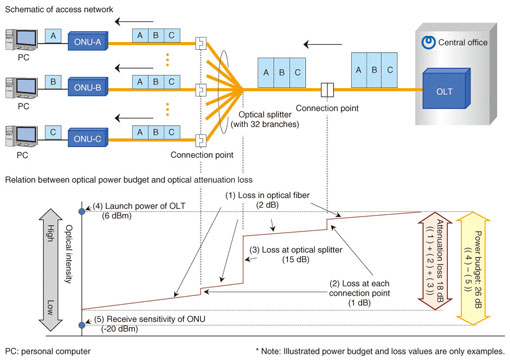
Fig. 1. Optical power budget and optical distribution network attenuation.
3. Optical power budget of NTT's GE-PON system
Even after the release of IEEE 802.3ah, we continued our access network development and considered using a splitting ratio of 1:32 and treating the non-ideal optical paths of actual optical networks. In 2004, NTT developed a GE-PON system with an optical power budget of 29 dB. Its 7-km span with a 1:32 optical splitting ratio covers more than 90% of the access networks in Japan.
4. Development of long-reach GE-PON system
For further FTTH service area expansion, a cost-effective GE-PON system with a span of greater than 7 km is required to provide rural coverage. There are three possible solutions:
(1) Improve the OLT's transmitter and receiver performances
(2) Improve the ONU's transmitter and receiver performances
(3) Improve the performances of both OLT and ONU
If the customers in the extended FTTH area (>7-km span) are uniformly distant from the OLT, the first option is most efficient because the cost of the OLT enhancement is shared by multiple customers (ONUs). For this reason, we chose to develop a long-reach OLT as the first step. A development summary is shown in Fig. 2. We have increased the OLT's power budget by 3 dB by using a high-efficiency aspheric lens and a high-output-power light-emitting diode in the transmitter and an improved amplifier control circuit and transimpedance amplifier in the receiver. As shown in Fig. 3, the existing OLT chassis can accommodate the new OLT packages alongside the conventional ones. This minimizes the cost of expanding the FTTH service area. The long-reach OLT yields an economical GE-PON system with a 32-dB optical power budget and allows FTTH services beyond 7 km from the central office. It was first deployed in 2010.
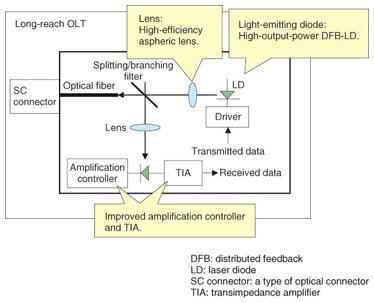
Fig. 2. Development summary of the long-reach OLT.
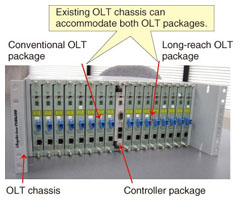
Fig. 3. OLT.
5. Development of even-longer-reach GE-PON system
FTTH service can be provided to the few, but more distant, customers, by developing long-reach ONUs (option 2 above). Our long-reach ONU is summarized in Fig. 4. The transmitter uses an aspheric lens in place of the previous spherical lens and a distributed-feedback laser diode. The receiver uses an avalanche photodiode. The ONU complies with IEC (International Electrotechnical Commission) class 1 requirements for eye safety [2], which is mandatory for equipment installed in customer premises. These improvements to the ONU side raise the power budget by 5 dB.
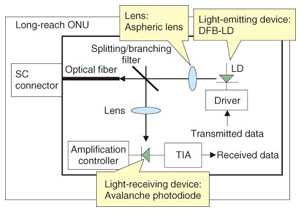
Fig. 4. Development summary of the long-reach ONU.
The new ONU matches the volume and power consumption of the conventional ONU. Since the OLT can accommodate both long-reach and conventional ONUs simultaneously, no special techniques are needed to install the new ONUs in the same PON network except for regular checks of the optical path attenuation. The combination of the long-reach OLT and the long-reach ONU provide an optical power budget of 37 dB, which is one of the highest budgets of any commercial GE-PON system in the world. NTT has started using this system to deploy FTTH services to customers more than 20 km from the central office (using a splitting ratio of 1:32).
6. Applications of long-reach GE-PON systems
The long-reach GE-PON system has three main application scenarios, as shown in Fig. 5: (1) expanding existing FTTH service areas, (2) adding new FTTH service areas for distant customers, and (3) providing FTTH services from a neighboring central office.
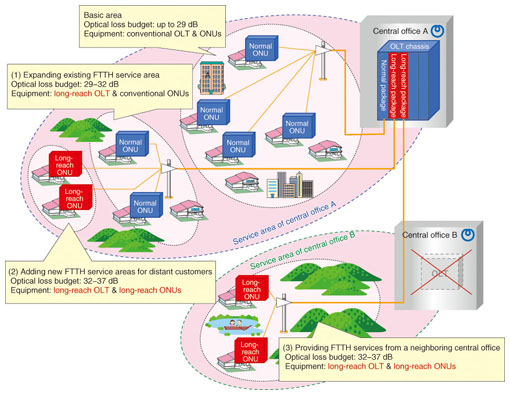
Fig. 5. Application scenarios of long-reach GE-PON.
By installing a long-reach OLT package in an existing OLT chassis, we can provide FTTH services to locations more than 7 km from the central office at minimum cost. For customers living in even further areas, we can deploy long-reach ONUs, but the higher installation cost imposes a limit because the long-reach ONUs will be deployed only to those customers rather than being shared among multiple customers. Although the basic concept of FTTH deployment is to connect ONUs to the nearest central office, some rural central offices do not have any fiber transmission systems. In such cases, it is possible to connect the ONUs to a more-distant neighboring central office that has OLTs and fiber transmission systems. The 37-dB power budget GE-PON system readily supports this kind of deployment.
7. Conclusion
We have developed a long-reach GE-PON system (with a splitting ratio of 1:32) that significantly expands the optical power budget from 29 dB to either 32 dB or 37 dB. These developments enable us to expand FTTH service areas cost-effectively. We have been supporting the commercial deployment of these systems and are thus contributing to further expansion of FTTH service areas in Japan.
References
| [1] | IEEE Std 802.3ah, 2004. |
|---|---|
| [2] | IEC 60825-1 Edition 2.0, 2007. |












